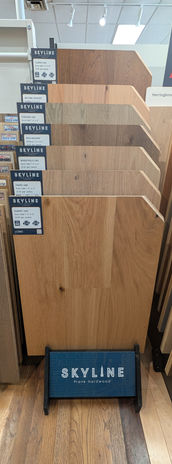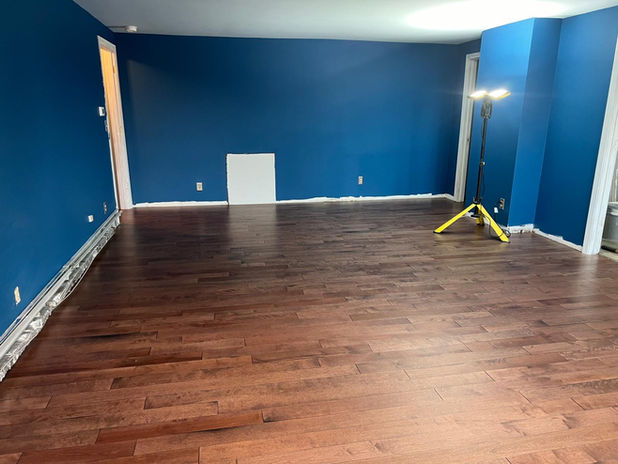Hardwood
Hardwood flooring is a timeless, durable, and elegant choice that adds warmth and character to any space. At Amazing Hardwood Floors, hardwood is our bread and butter—we specialize in high-quality hardwood installation and refinishing, providing beautiful, long-lasting results that enhance the natural beauty of your home.

Check Out Our Hardwood Selection!
Know Your Species.
No matter the finish protecting your hardwood, you cannot change the density of wood. Many scratches in hardwood are actually dents in the material. Jenka is the hardness scale used to measure a woods ability to withstand denting. The more dense the species is or higher the number, the more durable the wood.

Sawn Types

Plain Sawn
Quarter Sawn
Rift Sawn
Live Sawn

Hardwood flooring comes in different "cuts," meaning how the boards are sliced from the log. These cuts affect the look, feel, and even stability of your floor.
Plain Sawn (also called Flat Sawn):
How it's cut: The log is cut straight across, yielding boards with a classic "cathedral" or flame-like grain pattern.
Look: This is the most common cut, with the familiar swirling patterns you see in traditional hardwood floors.
Most affordable: This method is the most efficient and creates the least waste, making it the most cost-effective option.
Classic look: Many people love the traditional appeal of the plain sawn pattern.
Considerations: Plain sawn boards can be more susceptible to changes in humidity and temperature, which could lead to some expansion or contraction.
Quarter Sawn:
How it's cut: The log is first cut into quarters, and then each quarter is sawn perpendicular to the growth rings.
Look: This cut produces a linear, straight-grain pattern with a unique "flecking" or "ray" effect (especially noticeable in White Oak).
Increased stability: Quarter sawn boards are generally more stable and less prone to warping or cupping due to changes in moisture.
Durable: The tight grain structure makes them more resistant to wear and tear.
Considerations: Quarter sawn is more expensive than plain sawn because it produces more waste.
Rift Sawn:
How it's cut: Similar to quarter sawn, the log is quartered, but the boards are cut at a different angle to create a very straight and consistent grain.
Look: Rift sawn boasts a highly linear, sleek grain pattern with no prominent flecking.
Maximum stability: Rift sawn is the most dimensionally stable cut, offering the best resistance to moisture changes.
Premium aesthetic: The clean, straight lines are often desired for a formal or modern look.
Considerations: This is the most expensive cut due to the more complex sawing process and greater waste.
Live Sawn (also called European Cut or French Cut):
How it's cut: The log is cut straight through without rotating it, creating wide boards that display a mix of all three cuts: plain, quarter, and rift sawn.
Look: Live sawn boards showcase the full character of the log, including a variety of grain patterns and sometimes the natural heartwood and sapwood.
Unique appearance: This cut offers a natural and rustic look, perfect for wide plank flooring.
Good stability: Due to the presence of quarter sawn grain, live sawn boards offer better stability than plain sawn.
Environmentally friendly: This method uses the most of the log, making it a sustainable choice.
Floor Grading
Choosing the right hardwood floor is exciting, and understanding wood grades helps you pick the perfect look! Hardwood floor grades are based on the appearance of the wood, not its quality or durability.
Grade Appearance Character Marks Cost
Clear Uniform, Consistent Very few to none Highest
Select Mostly Uniform, Minimal (small knots) High
Some color/grain variation
#1 Common Noticeable Small Knots, Mid
Color/grain variation Mineral Streaks
#2 Common Significant Variation, Many knots, Low
Rustic Look Prominent marks

Clear
Select
#1 Common
#2 Common
Prefinished vs. Unfinished
Prefinished hardwood comes with a factory-applied finish, making it ready to install as soon as it arrives. This option offers faster installation, a consistent finish, and less on-site work or mess. Many prefinished floors include slight bevels or grooves between planks, allowing for minor subfloor inconsistencies.
While we take great care during installation, it’s important to note that prefinished boards are installed as-is, so minor marks or imperfections can occasionally occur in the process.
Unfinished hardwood (Sanded & Finished On-Site) is installed in its raw state, then sanded and finished on-site. This method allows for full customization of stain color and sheen, and it's ideal for achieving a smooth, seamless look—especially in large or open spaces.
However, this option does require more time and labor, as finishing is done after installation, often over several days.

Prefinished Sand & Finished
Engineered vs. Solid
Engineered Hardwood: Engineered hardwood is constructed from multiple layers of wood with a hardwood veneer on top, making it more stable and resistant to moisture and temperature fluctuations. It offers flexible installation options and can be used in areas like basements or kitchens. While it can only be sanded and refinished a limited number of times due to its thinner veneer, higher-quality engineered wood options, like Lauzon, provide wear layers similar to traditional hardwood floors. Contrary to common belief, high-quality engineered hardwood can be just as expensive, if not more so, than solid hardwood.
Solid Hardwood: Composed of a single piece of wood, solid hardwood offers a timeless, natural look and can be sanded and refinished multiple times over its lifespan. It is more sensitive to changes in humidity and temperature, making it better suited for climate-controlled environments. Solid hardwood is generally more expensive and requires a more involved installation process.

Solid Engineered
Moisture Maintenance
Maintaining proper moisture levels is essential for hardwood floors. The ideal moisture content should be between 6-9%, and room humidity should stay between 30-50%. Fluctuations in humidity can cause the wood to expand or shrink, leading to damage. Use a humidifier or dehumidifier to keep the environment stable and preserve the beauty and durability of your hardwood floors.

Completed Prefinished Hardwood Projects











